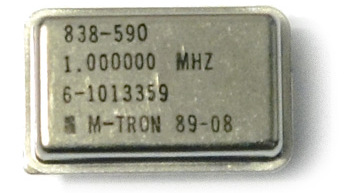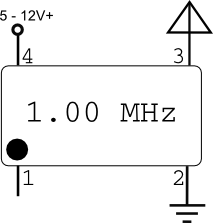Fun With Crystal Oscillators: Part 1
To get things kicked off, I thought it was best to start where I started.  Shortly after getting into shortwave radio listening, I wanted to create a radio transmitter of my own.  My knowledge about electronics was limited at the time (and admittedly still a step or two above novice), so a simple design was ideal.  I quickly found out that it's possible to make a very basic AM radio transmitter with one part and a 9v battery.
Introducing the crystal oscillator:


When a voltage is applied to the crystal oscillator it creates a square wave. Â Add a small length of wire as an antenna, and you have a radio transmitter. Â The above schematic shows how the oscillator is wired. Â Pin 2 is connected to ground (or negative on your 9v battery), pin 3 is connected to your length of wire used for an antenna, and pin 4 is connected to +9 volts. Â Pin 1 (the pin close to the dot) is ignored.
You can experiment with different voltages and power sources. Â I arbitrarily put 5 - 12 volts in the schematic, since it seemed like a normal range. Â The higher voltage will equal more RF watts output, but can also cause the crystal to get hot. Â With a 12 volt power supply, you can run the oscillator for a little while, but it will eventually heat up causing instability in the square wave output, and your signal will quickly degrade (you may also blow out your oscillator if it's not rated for 12v!). Â You will have more stability with a 9v battery since it has lower voltage and lower amperage, but in turn less watts output.
I'm using a 1 MHz crystal oscillator for my experiment, but you can use any value. Â A 1 MHz crystal will generate an AM signal starting at 1000 kHz (a.k.a. 1.00 MHz). Â If you have a 5 MHz crystal, you will need to tune to 5000 kHz on a shortwave radio. Â The advantage of the 1 MHz crystal is that you can use any standard AM receiver to hear your signal.
What will you hear? Â Assuming 1000 kHz is unused by commercial broadcasters in your area, before you apply power you should hear static on your AM receiver. Â After you apply power you will hear silence. Â If you don't, try moving your antenna closer to the radio, or lengthen your antenna. Â If all else fails, make sure you wired things up correctly.
Â
So, what will this little thing do? Â I created these two vines below to show you:
| Â Â Â Â | Â Â Â Â Â |
| Generating CW (a.k.a. morse code) ...Click on the sound icon to hear... |
1/4 watts RF! (Using a 12v power supply) |
Â
Wow, the crystal oscillator is pushing out around 1/4 watts of RF power! Â This was while plugged into a 12v power supply. Â You can also generate CW by connecting/unconnecting the power lead or the ground lead. You can hear a similar signal like in the above vine, if you have a short wave receiver that supports Single Side Band (SSB).
Now the downside. Â With simplicity, something is going to be sacrificed.
One unfortunate side effect of the square wave generated by the crystal oscillator is harmonics. Â If you have a radio that can do it, tune your dial (shortwave radio required) to 3000 kHz, and 5000 kHz, and 7000 kHz... Â Chances are, you will hear your AM carrier signal. Â You may also hear your signal by tuning an FM radio to 89.0 MHz, 91.0 MHz, and so on. Â This means that if you really want to use a crystal oscillator in any serious RF capacity you will need to filter the harmonic output, else you will run afoul of the FCC quickly as you pollute the radio waves with your signal. Â However, harmonics do dissipate as you go higher in frequency as shown in this graphic.
BUT, it's safe to experiment using short lengths of wire (a foot to several feet) for your antenna.  A full length half wavelength dipole antenna for 1000 kHz would be 456 feet long, which is likely a far cry from the length of wire you are currently using.  Using a 9v battery for power barely moves the RF watt meter, so you can add dozens of feet of wire for an antenna and still be safe.  Such experimentation is allowed by the FCC and should legally fall under their Part 15 rules (another link).  (I can't speak to laws in other countries.)
In all, the max normal range for such a transmitter is somewhere between a few feet to down the street from your home. Â
So, where can you get a crystal oscillator?  If you have an electronics store  in your area you might be able to find one, although Radio Shack doesn't carry any.  Luckily they are plentiful online.  You can even get them on Amazon.
Â

Continue reading:
Fun With Crystal Oscillators: Part 2
Fun With Crystal Oscillators: Part 3
admittedly
Posted: Jun 19, 2013
Keyword tags: basicstransmittercrystal oscillatorAM radioAM transmitter



